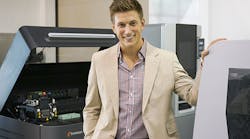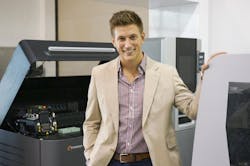3D printing or additive manufacturing has expanded to include injection molding. This new approach to manufacturing is changing the way companies design and develop products, including equipment destined for the healthcare industry. Derek Mathers, business development manager at Worrell Inc., a design, development, and strategy firm, discusses how 3D printing is changing the way companies operate and how the technology itself is continually changing.
What is 3D IM (3D injection molding) and why is your company interested in it?
We recently acquired a 3D printer, a Stratasys Objet Connex 500, and an 85-ton injection molding press, which we combined to create 3D injection molding (3D IM). It lets us 3D print the injection molds to manufacture small quantities of final prototypes – all with the same materials, components, and capabilities used in traditional 3D molding.
We identified early this year that a huge pain point for our customers comes after the prototyping phase and the design has been verified. That’s when medical companies must spend absurd amounts of time and money to create aluminum molds for production. Still, it’s common for clients to come back to us with design changes, which is a problem because that means the company has to reinvest in new tooling and throw away much , if not all, of what they just bought.
So how has the 3DIM process changed the way you develop medical devices?
It lets us print molds in just a couple of hours, and then turn out tens and even hundreds of prototypes within a few days. These end-use prototypes let our clients get through the FDA strict testing requirements in the same amount of time that their competitors are spending waiting for traditional aluminum molds to be made, often about six weeks. By getting a more complete FDA submission, thanks to the rapid production of final prototypes, our clients can successfully enter their sales cycle months ahead of schedule.
What are the major challenges in further developing this technology?
The two biggest constraints to wider use of the process are print speed and the type of materials used. The machines need to print at speeds 50 to 100 times their current rates to allow for printing the actual medical devices for end-use applications, and we believe this is possible. It would be a wildly disruptive innovation as it would eliminate most logistics, switching, labor, and assembly costs. Secondly, as more materials are developed including bioprinting and conductive materials, they will be used with existing manufacturing processes, including injection molding.
Another issue will be outsourcing for 3DIM and other 3D printing services. However, as the 3D printing industry is evolving, companies such as RP Marketplace are springing up to let rapid prototypers be quickly and securely sourced and managed.
Can you give an example in which a client benefited from 3DIM?
We recently worked on a project for OBMedical, a medical device firm based in Newberry, Fla. After we completed the final prototyping and our engineers refined the CAD model, we created the mold in SolidWorks and went directly into 3D IM to make end-use, injection-molded parts. This let us construct prototypes in their spec material without having to invest in tooling. OBMedical used these finished products for clinical trials and submitted their test data to the FDA in a fraction of the time it would've taken without 3D IM.
Are you planning to expand operations with more additive technologies?
Definitely. We see additive technology as being the preferred method of manufacturing in the future as it becomes more cost-inclusive. We want to raise awareness of 3DIM, as well as accelerate the disruptive nature of the medical devices we develop with the latest 3D printing technology. Our engineers are constantly exploring other 3D printing technologies we can apply in our designs, from Optomec's aerosol jet printing technology for applying conductive inks within injection molded parts to the implications of Organovo's bioprinting capabilities.
What are some other application/markets that can take advantage of 3DIM?
It should be used across every industry from consumer products to aerospace to accelerate the technology around us.

